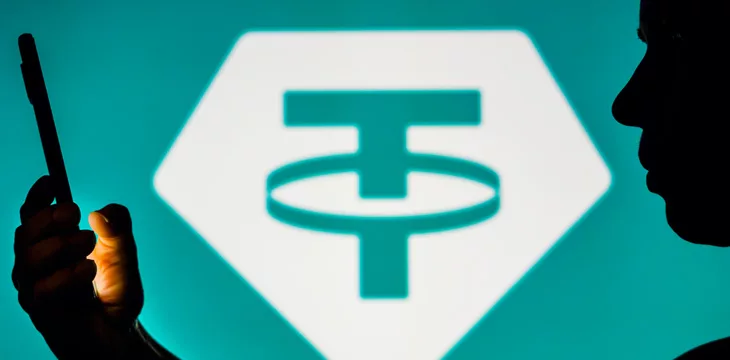|
Getting your Trinity Audio player ready...
|
Tether is coming under fire for reneging on its promise to eliminate third-party loans while also making a nearly half-billion-dollar investment in an artificial intelligence/BTC mining operation.
Tether’s most recent definitely-not-an-audit ‘attestation’ of the (alleged) assets backing its USDT stablecoin showed USDT-denominated loans to unspecified third parties rising by around $150 million from Q1 2023 to $5.5 billion as of June 30. The increase came despite Tether pledging to eliminate the loans from its balance sheet by the end of this year.
While sites like CoinGeek made note of this conflicting logic when the Q2 attestation was released last month, media heavies like the Wall Street Journal are now sounding the alarm regarding Tether’s backsliding. The WSJ quoted Tether spokesperson Alex Welch saying the loans were made after the company received “a few short-term loan requests from clients with whom we have cultivated longstanding relationships.”
Welch went on to claim that the loans were made “to prevent any significant depletion of our customers’ liquidity or the need for them to sell their collateral at potentially unfavorable prices, which could result in losses.” Welch insisted that Tether still intends to eliminate all loans by next year.
Welch’s comments raise all sorts of questions, including whether the additional $150 million represented the sum total of new lending—which would mean Tether didn’t move any of the Q1 loans off its books—or whether Tether collected on some old loans and the new loans exceed $150 million. There’s also no sense of how much lending Tether might have conducted since the end of Q2.
But primarily, we’re left wondering who among Tether’s minuscule list of direct customers is in such dire shape that they need hundreds of millions of dollars in outside funding to keep afloat. And what about the flatlining digital asset market has to change by the end of the year for these companies to no longer fear disaster?
Tether responded with a blog post accusing the WSJ of “tabloid-style reporting” aimed at “tarnishing the reputation of true innovators like Tether.” The company claimed that it could use its (self-reported) “$3.3 billion in excess reserves to effectively reduce secure loan exposure as net result.” Tether added that “anyone with a minimum understanding of financial markets” would see that being “on track to make a yearly profit of $4 billion” meant nobody should worry about Tether’s solvency.
Fortunately, Tether is the luckiest company in the world, having (allegedly) dodged every single major bankruptcy that has rocked the digital asset sector (and Chinese real estate) over the past 18 months or so. Even last year’s implosion of digital asset lender/Ponzi scheme Celsius, in which Tether was the third-largest stakeholder and to which Tether lent over $1.8 billion, didn’t break Tether’s stride. We’re sure this impressive run of good luck will continue forever, as all lucky streaks do.
U.S. Tetheries
Speaking of individuals with a ‘minimum understanding’ of financial realities, Tether released a different blog post earlier this month that addressed the company’s (alleged) billions in U.S. Treasury bills. The post was a curious mix of grandstanding, economic flexing and gross overestimations of Tether’s role in preserving America’s solvency.
Tether’s Q2 attestation cited $55.8 billion worth of T-bills, with additional exposure via ‘indirect’ investments such as overnight reverse repurchase agreements and money market funds. All told, these assets equaled $72.5 billion of the $83.2 billion in USDT in circulation as of June 30.
As Tether’s blog so helpfully explained, the percentage of T-bills held by foreign investors has fallen in recent years, primarily due to governments like China’s needing cash to kickstart their flaccid domestic economies. While others are selling, Tether has been buying, making Tether “a unique source of treasury demand while strengthening the role of the U.S. dollar globally.”
You see, what Tether really wants is to “help support U.S. and global financial stability.” Emerging markets are embracing USDT because people love the dollar but hate paying banking fees, assuming they have access to a bank account. Ergo: “If crypto does succeed as a global financial system, then demand for USDT is likely to increase exponentially, causing a sharp increase in U.S. Treasury buying from Tether.”
We’re sure anyone with a ‘minimum understanding’ of U.S. Treasury auctions would understand how insignificant Tether’s T-bill holdings are in the grand scheme of things. For instance, next Monday (25), the Treasury is auctioning off $131 billion worth of 13- and 26-week duration T-bills (plus $60 billion in 42-day bills and another $134 billion in longer-term notes). It does this every week. There are double-digit trillions’ worth of U.S. Treasury securities circulating as we speak.
Given these astronomical figures, as others have noted, “calling Tether a rounding error would be generous.”
Tether on the hunt for intelligence
Desperate for some positive news to throw off the dogs hot on their trail, Tether announced Thursday that it had made a “strategic investment into Northern Data Group,” a German firm involved in everything from cloud-based data centers to BTC mining operations.
Tether claimed the deal would see the parties collaborate on “several initiatives that aim to leverage AI, peer-to-peer communications, and super-resilient data storage solutions.” Forbes said the deal involved Tether spending $420 million to buy 10,000 H100 graphic processing units (GPUs) from red-hot chipmaker Nvidia (NASDAQ: NVDA). In exchange, Tether would receive a 20% stake in Northern Data, which plans to rent the use of these GPUs to third parties.
Predictably, Tether claimed the Forbes report contained “inaccuracies regarding Tether’s stake size in this investment” without offering further details. Tether also stressed that this investment wouldn’t “impact Tether’s reserves or customer funds.” That probably didn’t need stating, as nothing anyone ever does has any impact on Tether’s ‘choose your own adventure’ accounting.
But there are other aspects of this deal that warrant further scrutiny. The deal is being done through “Tether group company” Damoon (as in ‘to da moon’) Designated Activity Company. However, Northern Data announced in July that it was acquiring a 70% stake in the Dublin-based Damoon with an option to acquire the rest of this Irish shell at some unspecified future date.
Asked by Forbes why Tether was fronting the cash for the massive quantity of GPUs, Northern Data CEO Aroosh Thillainathan claimed that “we couldn’t go straight through to Nvidia…because everything is selling off really quickly so if you are not moving fast you are not getting the chips.” Which doesn’t really answer the question, nor explain why Tether had the necessary speed to achieve what Northern Data couldn’t.
Also unexplained is why a publicly traded firm like Northern Data would choose to align itself with Tether, which is currently under investigation for bank fraud, money laundering and facilitating terrorist financing. Then again, Northern Data appears to have a high tolerance for risk, as its other major investors include Block.one, the controversial developer behind the EOS protocol.
While Tether may not have much AI experience, it isn’t completely new to the mining biz. In May, it claimed to have invested unspecified “resources” into the launch of a new Uruguay-based “energy production” and BTC mining operation with an unidentified partner. (Honestly, you get more clarity from Magic 8-Balls.)
Regardless, the sheer size of the Nvidia GPU buy has raised eyebrows. As Forbes noted, Tether’s 10,000 GPU deal dwarfs recent chip investments by the likes of the U.K. and Saudi Arabian governments.
Nvidia’s chips are the new hot chick at the bar and with the U.S. government recently restricting the export of AI-capable chips like the H100 to countries like China, conspiracy theorists are already crafting rumors of in-out deals in which the chips are diverted to individuals/entities in nations who can’t buy them directly and will pay well above market rate.
Tether would likely deny the existence of such a scenario. But of course they would, wouldn’t they?
In order for artificial intelligence (AI) to work right within the law and thrive in the face of growing challenges, it needs to integrate an enterprise blockchain system that ensures data input quality and ownership—allowing it to keep data safe while also guaranteeing the immutability of data. Check out CoinGeek’s coverage on this emerging tech to learn more why Enterprise blockchain will be the backbone of AI.
Follow CoinGeek’s Crypto Crime Cartel series, which delves into the stream of group—from BitMEX to Binance, Bitcoin.com, Blockstream, ShapeShift, Coinbase, Ripple,
Ethereum, FTX and Tether—who have co-opted the digital asset revolution and turned the industry into a minefield for naïve (and even experienced) players in the market

 07-11-2025
07-11-2025 





